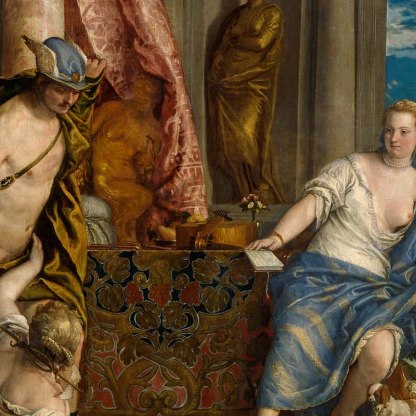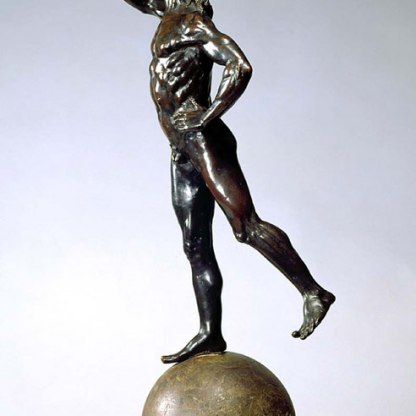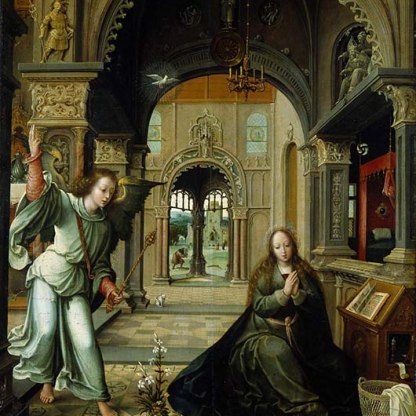Hermes, Herse and Aglauros

In 1573, Paolo Veronese found himself having to defend his art against accusations of 'indecorousness'. 'We painters', he declared, 'assume the same licence as poets and fools.' His sense of playful originality is to be found in this characteristically lively, sensual and colourful canvas. The subject, a rare one in painting, is taken from the Metamorphoses, the greatest work by the ancient Roman poet Ovid.
The messenger of the gods, Mercury, has fallen in love with Herse, an Athenian princess. When he comes to seduce her, Herse's sister, Aglauros, in a fit of jealousy, tries to prevent his entering her chamber. With one touch of his wand, the god transforms her into black stone, and gains access to his beloved.
Veronese's Herse does not seem overly concerned by the sudden intrusion of her divine suitor, and she stares with apparent indifference at the cruel and unusual fate of her sister. Ovid relates how Mercury fell in love with Herse when he saw her taking part in a procession of Athenian virgins, but Veronese here suggests that her fall from chastity is a foregone conclusion. At her left, a pure white flower lies on the floor. Her left breast and knee are casually but provocatively exposed.
A more surprising hint at the girl's imminent loss of sexual innocence is the obscurely painted yellow figure, squatting on the table and peeping out from behind the diagonal pink curtain that sharply divides the composition in two. It appears to have goat's legs and female breasts, and is probably a statue of a female satyr. The satyr is found in other paintings by Veronese, and was a familiar symbol of unbridled lust in antiquity. In a print in the Fitzwilliam, right [AD. 12.39-159], Rembrandt shows the king of the gods, Jupiter, taking on satyric form to make love to the nymph Antiope. Female satyrs are less common in art than their male counterparts, however, and this statue sits rather sinisterly beside the other more conventional, gentlewomanly objects on the tabletop: the bowl of fruit, the vase of flowers, the viol, the books of sheet music.
The other statue in the picture, half in shadow in the niche behind Herse, depicts a more modest, classical female. Clothed from neck to toe, with one arm covering her body, her face is turned away from the amorous god in the doorway.
Veronese dramatically catches the instant just before Aglauros' petrifaction. The shadow of Mercury's wand falls over her shoulders and back, a pink shadow that reflects the veins of the pink marble column in the corner of the room. This is the blow that will turn her from woman to statue, and the darkness it casts upon her skin anticipates the dark stone that she will become.
Veronese depicts a tremendously rich variety of textures within the painting: look at the flesh tones, the fabrics, the different types of marble, the wood of the viol, the gold of the statue, the fur of the tiny spaniel at Herse's feet. These all exemplify the decorative skill for which the artist is still celebrated, and reflect the great material wealth of Venice, where Veronese spent so much of his working life.
In his poem Ovid wittily describes how Mercury takes pains to enhance his innate Olympian beauty. The god is near naked here, but Veronese still manages to convey the idea of a young dandy who has preened himself before meeting his girl. He wears a black and white cameo on his sash, a badge in the middle of his blue feathered cap and a rather incongruous, but somehow appropriate, little moustache. It is no surprise to learn that Veronese also designed stage costumes.
The sense of theatricality is also reflected in the architecture. In 1579 the great Venetian architect Andrea Palladio began designing a theatre based on the writings of the ancient Roman architect and theorist Vitruvius. The Teatro Olimpico can still be seen today in Vicenza, and the elaborate stage architecture, left, has much in common with Herse's chamber: compare the pillars with their carved capitals, the statue in its niche, the pediment above the doorway.
Themes and periods
Data from our collections database
Probably coll. Emperor Rudolph II (d. 1612); Imperial collection, Prague, by 1621; taken to Sweden after the fall of Prague, 1648; Queen Christina of Sweden, Rome (d. 1689); Orleans family; exh. for sale, London, Lyceum, 1798/9 (200), not sold; sale London by Coxe, Burrell and Foster, Mr Bryan's Gallery, 14 Feb. 1800 (49), bt. Walton
Legal notes
Founder's Bequest
Acquisition and important dates
- Method of acquisition: Bequeathed
- Dates: 1816
Dating
Maker(s)
- Veronese (Paolo Caliari) Painter
Materials used in production
Read more about this recordStories, Contexts and Themes
Other highlight objects you might like
Suggested Curating Cambridge products
Sign up to our emails
Be the first to hear about our news, exhibitions, events and more…






